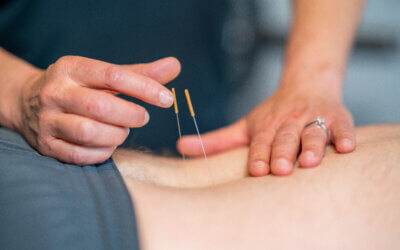Temporomandibular joint disorder (TMJ) can be a painful condition. It affects the jaw joint and its surrounding muscles. It can lead to disruptions and severely impact your overall quality of life. For those dealing with TMJ issues, seeking physical therapy can provide them with effective relief and can help improve their quality of life.
What is TMJ?
The temporomandibular joint (TMJ) is a hinge-like joint that connects your jaw to your skull. It connects at the temporal bones, which are just in front of your ears. This joint allows you to move your jaw up and down, side to side, and back and forth. It allows you to complete essential functions: eating, speaking and even yawning. TMJ disorder affects up to 12% of people.
What are symptoms of TMJ?
TMJ disorder can cause a variety of symptoms that can include:
- Jaw pain — One of the most common symptoms of TMJ disorder is jaw pain. This pain is often described as an ache or tenderness around the jaw joint area.
- Headaches — TMJ-related headaches can be a common issue. They are similar to tension-type headaches and can affect both sides of the head.
- Clicking or popping sounds — Many people with TMJ disorder can experience a clicking, popping or grating sound when they open or close their mouths.
- Facial pain — Pain or tenderness in the face, particularly around the cheeks and jawline, can be indicative of TMJ.
- Pain while chewing — Chewing or speaking can exacerbate jaw pain. This can make it challenging to enjoy eating or engage in conversation.
- Limited jaw movement — TMJ disorder can lead to a limited range of motion in the jaw. This can make it incredibly difficult to fully open the mouth.
- Ear symptoms — This pain can lead to sensations of fullness or discomfort in the ears, making the TMJ-related pain be mistaken for ear problems. It can also cause ringing or itching sensations in the ears.
- Dental issues — TMJ disorder can cause dental issues such as teeth misalignment or teeth grinding.
- Radiating pain — Pain caused by TMJ can radiate into the shoulder, neck, scalp and face.
How is TMJ pain treated?
TMJ pain can respond to a number of treatment approaches. These treatment approaches can include:
- Medication — Your dentist or physician may recommend you take over-the-counter nonsteroidal anti-inflammatory drugs to help with pain relief. If your TMJ pain is on the severe side, they may also prescribe muscle relaxants to help provide relief from muscle spasms and tension.
- Cognitive behavioral therapy (CBT) — CBT can be used in conjunction with other treatments. It can help you learn to cope and to stop having a catastrophizing mentality around the pain and treatment of TMJ disorder.
- Physical therapy — Your dentist or physician may recommend you seek physical therapy near you to help you find relief from your TMJ pain.
Why should you consider TMJ physical therapy near you
TMJ physical therapy can offer you an effective treatment approach to help manage your TMJ disorder. A licensed physical therapist will take your medical history, symptoms and findings from a physical evaluation into account to create a custom treatment plan. This plan will be designed specifically with your needs and challenges in mind. The main intention of this treatment plan will be to help reduce pain and discomfort that TMJ disorder is causing you. Physical therapy treatment approaches can include:
- Jaw exercises — Your physical therapist may guide you through jaw exercises. These exercises are intended to help improve your jaw mobility and strengthen the muscles surrounding the jaw joint. These exercises may include resistance exercises or gentle stretches.
- Manual therapy — Hands-on techniques, like soft tissue mobilization and joint mobilization, may be used by your physical therapist. These techniques are intended to help relieve muscle tension and improve your joint function in your jaw and neck.
- Electrical stimulation — Electrical stimulation can be a beneficial physical therapy treatment for TMJ pain by using a low-level electrical current to help alleviate pain signals, reduce muscle tension and inflammation, and boost circulation to promote healing.
- Iontophoresis — Iontophoresis is a noninvasive treatment approach that uses a low-level electrical current to administer medication through the skin. This can help provide pain relief.
- Dry needling — Dry needling is a technique used by certified physical therapists. They insert thin, sterile needles into trigger points or tight muscles. This is intended to help provide pain relief and improve muscle function.
- Instrument-assisted soft tissue mobilization (IASTM) — IASTM can help break up scar tissue or muscle tension that is associated with TMJ pain. This can help relieve inflammation and provide pain relief.
Physical therapy near you can offer you a holistic approach to managing your TMJ disorder symptoms. Combined with any recommended lifestyle changes, you may experience pain relief and improved quality of life. Physical therapy can help address the root cause of your TMJ pain and give you the knowledge to most effectively manage your condition.
Continuum Wellness is the physical therapy you need for TMJ pain
Continuum Wellness provides physical therapy treatments near you for TMJ pain. Our expert physical therapists understand the significant impact TMJ disorder can have on your daily life. Our team is committed to designing customized treatments intended to help alleviate your pain, improve your jaw function and improve your overall quality of life. Don’t let TMJ pain continue to hold you back. We can help guide you to a more comfortable life, right here in your local community.
Contact our team today for more information or to schedule an initial appointment.



